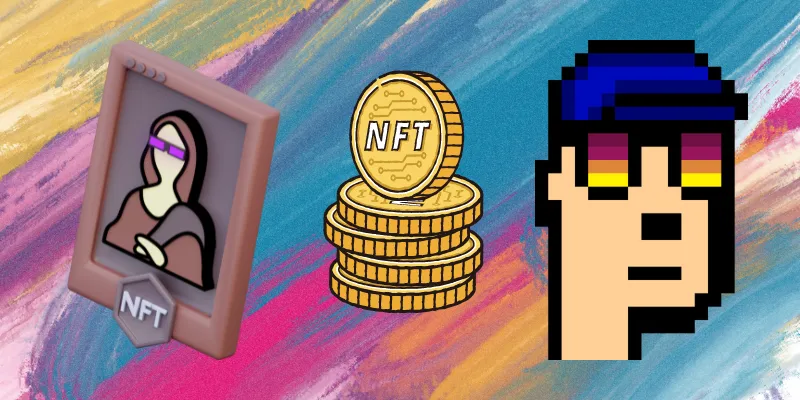Ever wondered why people are spending millions on digital images and GIFs? It might sound bizarre, but NFTs, or Non-Fungible Tokens, have become a huge phenomenon in the digital world. Whether it’s art, music, or even virtual real estate, NFTs are making waves. But what exactly are they, and why should you care?
In this article, we’ll break down the essential things you need to learn about NFTs, helping you understand why they’re more than just a buzzword. From how they work to their potential impact, we’ve got you covered. Let’s learn NFTs and discover what makes them so fascinating.

NFTs, or Non-Fungible Tokens, are like digital collectibles. Imagine you have a rare baseball card or a unique piece of art. You know it’s special because there are only a few like it in the world, and it can’t be swapped for just any other card or painting. NFTs work the same way, but in the digital world.
When you buy an NFT, you’re buying a unique digital item. This could be a digital painting, a piece of music, a video, or even a tweet. The special thing about NFTs is that they are one-of-a-kind, thanks to blockchain technology. Think of blockchain as a huge, super-secure digital ledger that records who owns what. It’s like a digital certificate of authenticity that everyone can see, so you know your NFT is genuine.
Here’s a simple way to think about it: If regular digital files are like copies of a famous book that anyone can download, an NFT is like owning the original handwritten manuscript. It’s unique, verifiable, and valuable because of its rarity.
NFTs have become popular because they give digital items the same uniqueness and value that physical collectibles have. This uniqueness makes them special and sought after, turning them into a new way for artists, musicians, and creators to sell their work and for collectors to invest in digital assets.
Feeling inspired and want to create your own? Kittl has emerged as a popular app for creating high-quality images to sell as NFTs.
You Might Also Like:

NFTs operate using blockchain technology, which is a digital ledger. This ledger records all transactions and ensures that each NFT is unique and can’t be duplicated. Here’s a simple way to understand it:
Imagine you have a digital painting. When this painting is turned into an NFT, it gets a special code that says, “This is the original.” This code is stored on the blockchain, making it visible to everyone and verifying its authenticity. Think of the blockchain as a giant public record book that anyone can check to see who owns what.
To create an NFT, an artist or creator uses a process called “minting.” Minting is like stamping a unique serial number on a product. Once minted, the NFT can be bought, sold, or traded on various online marketplaces. When someone buys an NFT, the blockchain updates to show the new owner, ensuring the item’s history and ownership are always transparent and secure.
This system not only keeps track of ownership but also makes it impossible to forge or alter the NFT without everyone knowing. This transparency and security are what make NFTs so valuable and trustworthy.

NFTs have found their way into various fields, transforming how we think about ownership and value in the digital world. Here are some popular uses:
Digital Art: Artists create digital pieces and sell them as NFTs. This gives digital art the same uniqueness and value as physical art. Buyers can own a unique piece of digital art, complete with a certificate of authenticity.
Music and Media: Musicians and content creators are using NFTs to sell their work directly to fans. For example, a musician might release a limited edition track as an NFT, allowing fans to own a unique piece of music history.
Virtual Real Estate: In virtual worlds like Decentraland and The Sandbox, users can buy, sell, and trade virtual land as NFTs. This virtual real estate can be developed, rented out, or sold, much like physical property.
Collectibles and Memorabilia: NFTs are also used for digital collectibles. Think of them as modern-day trading cards, where each card is unique and can be bought, sold, or traded on online marketplaces.
Gaming: In the gaming world, NFTs are used to represent in-game items, such as weapons, skins, or characters. These items can be owned, traded, and sold outside of the game, giving players real ownership of their digital property.

Trading in NFTs might seem tricky at first, but it’s quite straightforward once you get the hang of it. Here’s a simple guide to help you learn NFT trading:
Choose a Marketplace: First, you need to select a marketplace where NFTs are traded. Some popular ones include OpenSea, Rarible, and Foundation. Each marketplace has its own features, so explore a few to see which one you prefer.
Set Up a Digital Wallet: To buy NFTs, you need a digital wallet to store your cryptocurrencies and NFTs. Wallets like MetaMask, Coinbase Wallet, and Trust Wallet are popular choices. These wallets allow you to store, send, and receive cryptocurrencies like Ethereum, which is commonly used to buy NFTs.
Add Funds to Your Wallet: Once you have a digital wallet, you need to add funds to it. Most NFTs are bought with Ethereum, so you’ll need to buy some from an exchange like Coinbase or Binance and transfer it to your wallet.
Browse and Buy: Now you’re ready to browse the marketplace for NFTs you like. When you find one you want to buy, simply follow the marketplace’s process for purchasing. This usually involves clicking a “Buy” button and confirming the transaction through your digital wallet.
Selling an NFT: If you want to sell an NFT you own, you’ll list it on a marketplace. You can set a fixed price or put it up for auction. Once someone buys your NFT, the marketplace will handle the transaction, and the buyer’s payment will be transferred to your wallet.
Remember, every transaction is recorded on the blockchain, ensuring transparency and security. This process might seem complex at first, but with a bit of practice, buying and selling NFTs becomes a routine.

When you buy an NFT, you’re not just getting a digital file; you’re gaining a unique proof of ownership. Here’s what that means:
Proof of Ownership: Owning an NFT means you have a digital certificate that proves you own a unique item. This certificate is stored on the blockchain, making it visible to everyone and nearly impossible to forge. Think of it like having a deed to a piece of property, but for a digital item.
Usage Rights: While owning an NFT proves you own the original digital item, it doesn’t always give you full rights to use or reproduce the item however you want. The specific rights you get can vary based on what the creator has included in the terms of the sale. For example, owning an NFT of a digital artwork doesn’t necessarily mean you can make prints of the artwork and sell them. It’s important to understand what rights come with the NFT you’re buying.
Resale Rights: One of the benefits of NFTs is that they can be resold. When you sell an NFT, the blockchain updates to show the new owner, and you receive payment in cryptocurrency. Some NFTs also include royalties, meaning the original creator gets a percentage of the sale price whenever the NFT is resold. This feature ensures that creators continue to benefit from their work even after the initial sale.
Access and Utility: Some NFTs offer additional perks beyond ownership. For instance, owning an NFT might give you access to exclusive content, events, or communities. These added benefits can make certain NFTs more valuable and appealing to buyers.

Investing in NFTs can be exciting and potentially profitable, but it comes with its own set of risks and rewards. Here’s what you need to know:
Value Determination: The value of an NFT is determined by several factors, including its rarity, the reputation of the creator, and its popularity. Just like with traditional art, an NFT created by a well-known artist or part of a limited series tends to be more valuable. Additionally, NFTs that offer extra benefits, like access to exclusive content or communities, can also be worth more.
Market Volatility: The NFT market can be highly volatile. Prices can skyrocket one day and plummet the next. This volatility means that while there is potential for high returns, there’s also a significant risk of losing money. It’s important to be cautious and not invest more than you can afford to lose.
Research and Due Diligence: Before investing in any NFT, do your research. Look into the background of the creator, the history of the NFT, and its performance in the marketplace. Check if the NFT has any unique features or benefits that add to its value. Being well-informed can help you make smarter investment decisions.
Long-Term vs. Short-Term: Decide whether you’re looking for a long-term investment or a quick flip. Some investors buy NFTs with the hope that their value will increase over time, while others aim to sell them quickly for a profit. Your strategy will influence which NFTs you choose to buy.
Scams and Fraud: Be aware of scams in the NFT sphere. Since the market is relatively new, it attracts bad actors looking to take advantage of inexperienced buyers. Always use reputable marketplaces, double-check the authenticity of the NFTs, and be wary of deals that seem too good to be true.
Diversification: Just like with any investment, it’s wise to diversify your portfolio. Don’t put all your money into a single NFT or creator. Spread your investments across different types of NFTs and artists to minimize risk.

When dealing with NFTs, it’s important to understand the legal landscape to avoid potential pitfalls. Here are some key legal considerations:
Copyright Issues: Buying an NFT does not necessarily mean you own the copyright to the underlying asset. For example, purchasing an NFT of a digital artwork doesn’t automatically give you the right to reproduce, distribute, or modify the artwork. It’s crucial to check the specific terms and conditions set by the creator to know what rights you are actually purchasing.
Intellectual Property: NFTs can involve various intellectual property rights, including trademarks and patents. If you create an NFT that includes someone else’s intellectual property without permission, you could face legal consequences. Always ensure you have the rights to the content you’re minting as an NFT.
Regulation: The regulatory environment for NFTs is still evolving. Different countries have different laws regarding digital assets, and these laws can affect how NFTs are created, bought, and sold. For example, some jurisdictions might classify certain NFTs as securities, subjecting them to stricter regulations.
Taxes: Buying, selling, and trading NFTs can have tax implications. In many places, profits from NFT transactions are considered taxable income. It’s essential to keep detailed records of your transactions and consult with a tax professional to ensure you comply with all tax obligations.
Consumer Protection: Be aware of potential scams and fraudulent activities in the NFT world. Since the market is relatively new, it has attracted bad actors looking to take advantage of unsuspecting buyers and sellers. Use reputable marketplaces, verify the authenticity of NFTs, and be cautious of deals that seem too good to be true.

The NFT space is rapidly evolving, with new trends and innovations emerging all the time. Here are some future trends to watch out for:
Interoperability: As the NFT ecosystem grows, there will likely be more focus on interoperability between different platforms and blockchains. This means that NFTs could be used and traded across various marketplaces and virtual worlds seamlessly, increasing their utility and value.
Integration with Augmented Reality (AR) and Virtual Reality (VR): NFTs are expected to become more integrated with AR and VR technologies, creating immersive experiences for users. For example, you might be able to display your digital art NFTs in a virtual gallery or use virtual real estate NFTs in an AR environment.
Mainstream Adoption: As more major brands and celebrities enter the NFT arena, mainstream adoption is expected to grow. This could lead to increased acceptance and understanding of NFTs among the general public, driving further innovation and investment.
Enhanced Utility: NFTs are likely to offer more utility beyond just ownership. For example, owning an NFT might grant you access to exclusive events, memberships, or digital and physical perks. This added utility can make NFTs more attractive and valuable to buyers.
Environmental Solutions: With growing concerns about the environmental impact of NFTs, there will likely be more efforts to develop eco-friendly blockchain technologies and practices. This could include transitioning to less energy-intensive consensus mechanisms and implementing carbon offset programs.
These trends indicate that NFTs are not just a passing fad but a significant development in the digital landscape. Keeping an eye on these trends can help you stay ahead in the ever-evolving world of NFTs.
If you’re interested in exploring the world of NFTs, here’s how to get started:
Learn the Basics: Begin by educating yourself about NFTs, blockchain technology, and how the market works. A great place to start is 101 Blockchains, a platform offering high-quality online courses and certifications in blockchain and Web3. Their courses are created by industry experts and cover essential topics like blockchain fundamentals, smart contracts, Ethereum, and NFTs, making the content easy to follow and understand.

Set Up a Digital Wallet: To buy and sell NFTs, you’ll need a digital wallet to store your cryptocurrencies and NFTs. Popular wallets include MetaMask, Coinbase Wallet, and Trust Wallet.
Buy Some Cryptocurrency: Most NFTs are purchased with cryptocurrencies like Ethereum. You’ll need to buy some from a cryptocurrency exchange and transfer it to your digital wallet.
Choose a Marketplace: Explore different NFT marketplaces such as OpenSea, Rarible, and Foundation. Each platform has its own unique features and types of NFTs available.
Start Small: If you’re new to NFTs, it’s wise to start small. Look for affordable NFTs to begin with, so you can learn the ropes without risking too much money.
Stay Informed: The NFT space is constantly evolving. Follow news and updates from reliable sources to stay informed about new developments, trends, and opportunities.
Design Your Own NFTs: Use your graphic design skills to create unique digital art. Tools like Adobe Illustrator, Photoshop, and Kittl can help you craft high-quality designs. Experiment with different styles and themes, and consider adding animations or interactive elements to make your NFTs stand out.
By taking these steps, you can start your journey into the world of NFTs with confidence and excitement.
What does NFT stand for?
NFT stands for Non-Fungible Token.
How are NFTs different from cryptocurrencies?
While both NFTs and cryptocurrencies use blockchain technology, cryptocurrencies are fungible, meaning each unit is identical and can be exchanged for another. NFTs are unique and cannot be exchanged on a one-to-one basis.
Can anyone create an NFT?
Yes, anyone can create an NFT by minting a digital item on a blockchain using an NFT marketplace.
What are some popular NFT projects?
Popular NFT projects include CryptoPunks, Bored Ape Yacht Club, and NBA Top Shot.
Is it safe to invest in NFTs?
Investing in NFTs carries risks, just like any other investment. It’s important to do your research, understand the market, and only invest what you can afford to lose.
How do I store my NFTs?
NFTs are stored in digital wallets that support the blockchain they are minted on, such as MetaMask or Trust Wallet.
What is minting an NFT?
Minting an NFT is the process of creating a new NFT on a blockchain. This involves uploading your digital file to an NFT marketplace and paying a transaction fee.
Can NFTs be copied?
While the digital file associated with an NFT can be copied, the NFT itself, which includes proof of ownership and authenticity, cannot be duplicated.
What makes an NFT valuable?
The value of an NFT is often determined by its rarity, the reputation of the creator, and the demand for it. Unique features or benefits, like access to exclusive content, can also add value.
Are there any ongoing costs with owning an NFT?
Generally, there are no ongoing costs with owning an NFT. However, if you plan to sell or transfer it, there may be transaction fees.
What are gas fees?
Gas fees are transaction fees paid to miners on a blockchain network, like Ethereum, for processing transactions and minting NFTs.
Can NFTs be used in games?
Yes, NFTs can be used in games to represent in-game items, characters, or skins that players can buy, sell, and trade.
What is the difference between ERC-721 and ERC-1155 tokens?
ERC-721 is a standard for creating unique, single-instance NFTs. ERC-1155 allows for the creation of both unique and fungible tokens within a single smart contract, making it more versatile.
What are some common scams in the NFT space?
Common scams include fake marketplaces, phishing attacks, and counterfeit NFTs. Always use reputable platforms and verify the authenticity of NFTs before purchasing.
How do royalties work with NFTs?
Some NFTs are designed to pay royalties to the original creator every time the NFT is resold. The terms for royalties are usually set during the minting process and enforced by smart contracts.












